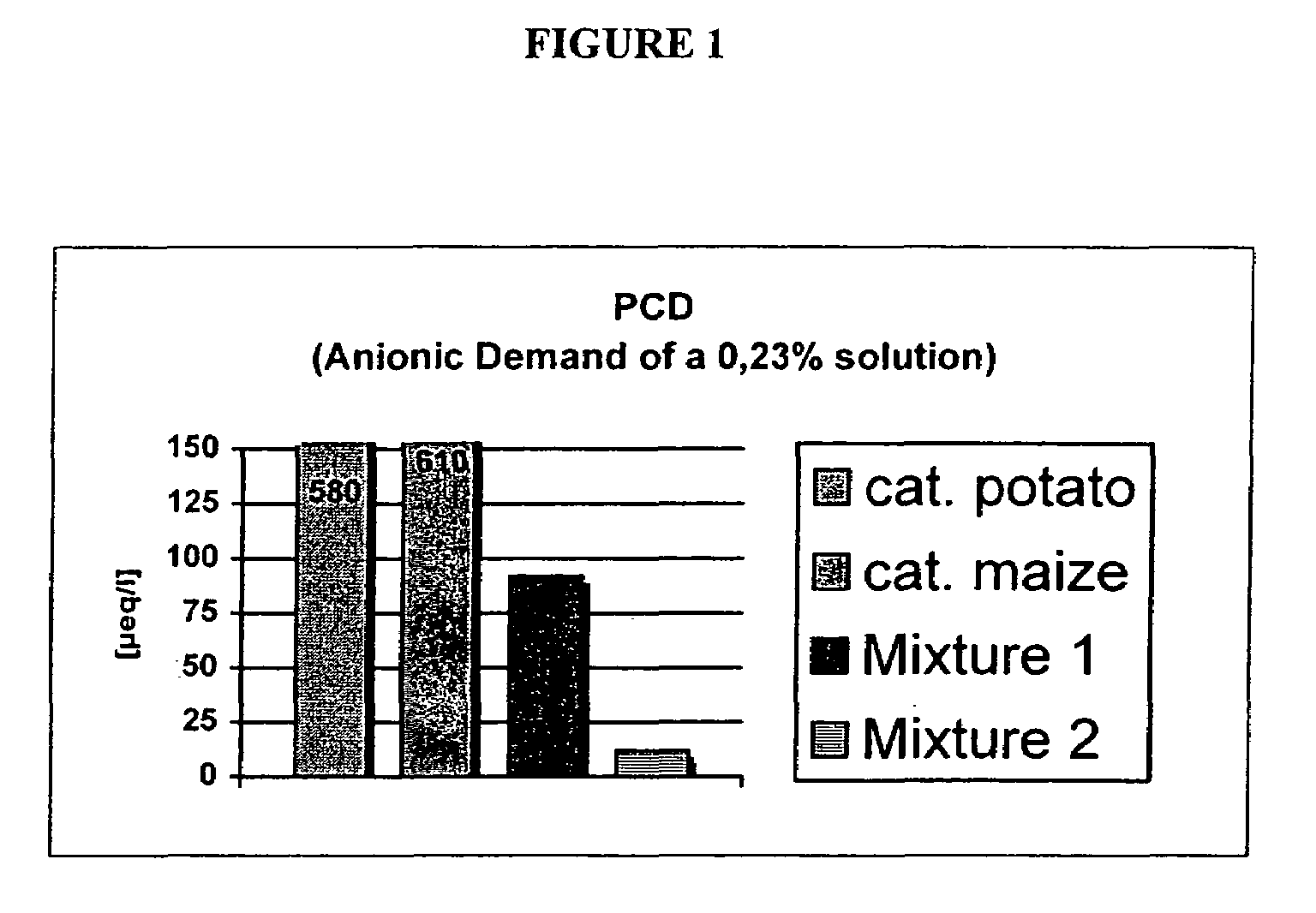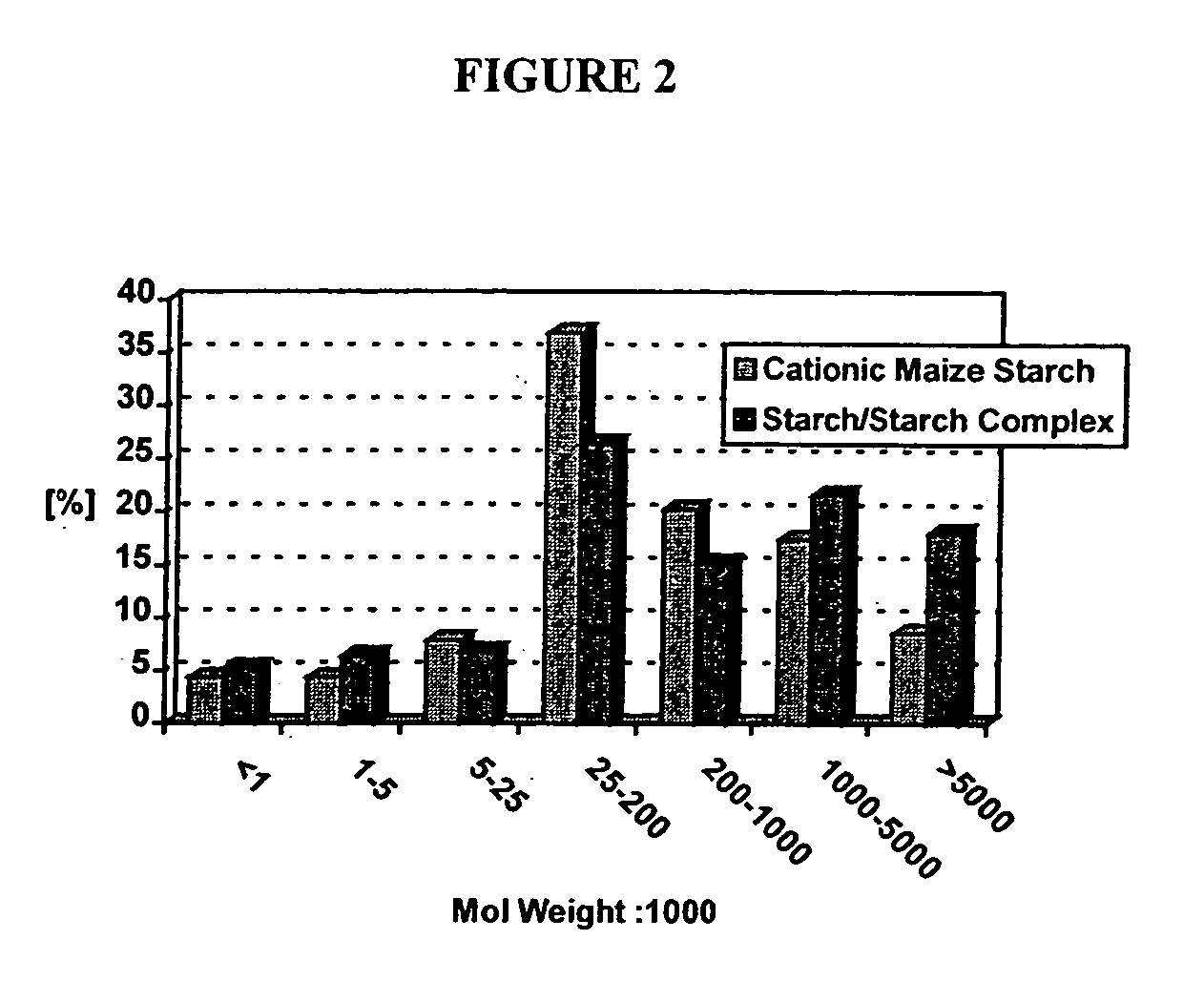Starch compositions and the use thereof in wet-end of paper preparation
a technology of starch composition and wet-end paper preparation, which is applied in the field of starch compositions, can solve the problems of limited increased level of starch or polymer addition, and limited maximum amount of polymer that can be added, etc., and achieves the effect of increasing strength characteristics and being easy to add
- Summary
- Abstract
- Description
- Claims
- Application Information
AI Technical Summary
Benefits of technology
Problems solved by technology
Method used
Image
Examples
example 1
Starch Compositions
[0053]The anionic demand of the starch mixtures of the present invention was determined and compared with the anionic demand of the normal cationic starches. FIG. 1 discloses the charge situation of two cooked compositions (starch / starch) consisting of 60% (w / w) anionic waxy starch (modified with maleic anhydride) and 40% (w / w) cationic maize starch (D.S. (degree of substitution): 0.042) or 40% (w / w) cationic potato starch (D.S.: 0.040).
[0054]The quantities and charge densities of the two components of the mixtures have to be selected in a way that provides the final cooked complex of the two polymers with a slight cationic net charge, which is high enough to enable the complex to be retained in the anionic fibre / filler matrix. The cationic charge has to be sufficient for retention, but on the other hand low enough to avoid overcharging of the system at higher addition rates than 2.5%.
[0055]FIG. 2 shows the different molecular weight of the mixture compared to a t...
example 2
Paper Preparation with Compositions Containing Cationic and Anionic Starches
[0056]Several lab investigations were performed. Lab sheets were made on a TECHPAP lab sheet former (retention tester) and were investigated with respect to properties according to standardised international paper testing methods.
Method for Lab Sheet Forming.
[0057]Fibres are prepared in a mixing device according to the recipe of the furnish being used on the paper machine with a consistency of 0.5 to 1.0% dry substance. Depending on the paper quality some filler such as carbonate and some recycled fibres (coated and uncoated) are additionally applied.
[0058]A defined volume (depending on the grammage of the paper) of this composition is transferred to the TECHPAP retention tester. This equipment consists of a baffled cylinder with an adjustable stirrer and a valve to release the pulp suspension onto a wire. situation. Under normal conditions the charge and therefore the PCD response has to be fixed. The stirr...
example 3
[0078]Experiments were performed on large-scale equipment to confirm the lab scale tests. Results are shown in Table 3.
[0079]
TABLE 3Results of a full scale machine trialTrial 2.5%Reference 5% SizeComposition ofPress Starch + 0.9%Anionic + CationicWet-End StarchStarchMachine Speed[m / min]225250Machine Production[t / hour]9.111.06Scott Bond[units]195255Tensile Strength[m]5,4006,900Ash[%]8.37.4
[0080]This trial was performed on a twin wire Fourdrinier machine producing coating base paper. The grammage was 190 g / m2. The starch mixture was cooked by steam injection (jet cooking) at 125° C. and dosed at the machine chest (same addition point like the conventional wet-end starch).
[0081]Table 3 shows that the addition of 2.5% of the composition according to the present invention gives a machine and product performance which is above that when size press starch and wet-end starch are used. The ash content is lower and the paper strength is increased moreover the machine speed is increased or at ...
PUM
| Property | Measurement | Unit |
|---|---|---|
| w/w | aaaaa | aaaaa |
| w/w | aaaaa | aaaaa |
| w/w | aaaaa | aaaaa |
Abstract
Description
Claims
Application Information
 Login to View More
Login to View More - R&D
- Intellectual Property
- Life Sciences
- Materials
- Tech Scout
- Unparalleled Data Quality
- Higher Quality Content
- 60% Fewer Hallucinations
Browse by: Latest US Patents, China's latest patents, Technical Efficacy Thesaurus, Application Domain, Technology Topic, Popular Technical Reports.
© 2025 PatSnap. All rights reserved.Legal|Privacy policy|Modern Slavery Act Transparency Statement|Sitemap|About US| Contact US: help@patsnap.com


